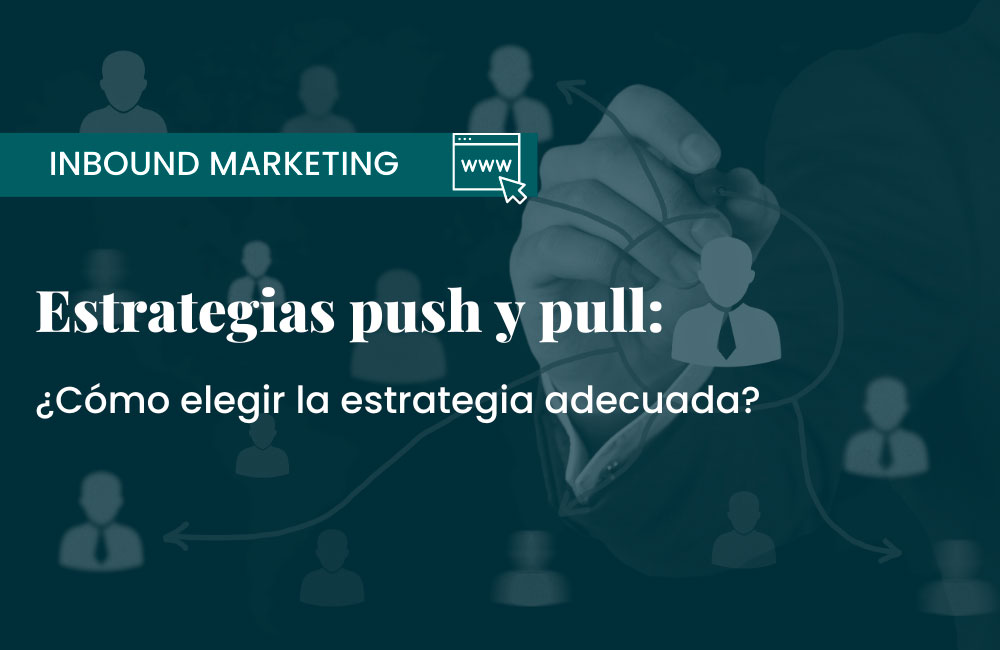In the world of marketing, there are various strategies aimed at capturing consumers’ attention and driving sales. Two of the most popular are the pull and push strategies. Both marketing strategies have very different approaches, but their end goal is the same: persuade the audience to purchase a product or service. Want to learn a bit more about them?
Push and pull strategy
If you’re thinking about launching a product or service to the market, it’s important to choose the right marketing strategy to achieve the desired success. In this article, we’ll present both push and pull strategies and the factors you should consider before making a decision. Not all cases are the same, and factors such as your brand positioning, the market, your resources, or product demand can be decisive when choosing. So, are you ready to discover which option is best for you? Let’s begin!
What is push marketing?
Push marketing is a sales technique focused on “pushing” the product or service toward the consumer through advertising and active promotion. In other words, it’s a strategy that aims to persuade the customer by constantly exposing them to the product, even when there isn’t necessarily prior specific demand.
In this type of strategy, the main objective is to create a need in the consumer and get them attracted to the product. Therefore, it’s common to use media such as TV, radio, and print ads, as well as online advertising, along with promotional techniques like special offers, discounts, free samples, and product demos.

Push marketing is especially effective for mass-consumption products, where there’s high market competition and customers aren’t necessarily actively looking to buy. By creating constant exposure, the goal is to keep the product top of mind when it’s time to purchase.
However, this strategy may also have drawbacks. For example, saturating the consumer with advertising can generate resistance toward the product, making the advertising message less effective. In addition, this type of strategy can be costly, especially when using mass media.
Examples of push marketing
There are various examples of push marketing visible in the market. One is TV and radio advertising that “pushes” the product to the consumer through constant exposure. For example, soft drink or alcoholic beverage campaigns broadcast during prime-time TV and radio are examples of this strategy. These ads aim to create a need in the consumer and encourage consumption through repeated exposure.
Another example is the use of promotional techniques such as discounts and special offers. For instance, a retail chain might run a “buy one, get the second at half price” promotion to incentivize purchases. These offers are actively promoted through flyers, billboards, and online to push the product toward the consumer and generate demand.
Finally, push marketing can also be seen in the distribution of free samples and product demonstrations. For example, a perfume brand might hand out samples to customers in a department store to spur potential purchases. Live product demos—such as a makeup brand conducting an in-store demonstration—can also encourage sales.
Push marketing uses various techniques such as advertising, promotions, and free samples to “push” the product toward the consumer and generate potential demand. These are just a few of many examples in today’s market.
What is pull marketing?
Pull marketing is a strategy focused on “attracting” the consumer to the product by building a strong brand and a positive market image. This strategy is based on the idea that consumers are drawn by a brand’s quality and reputation, not just product features.
In pull marketing, the company aims to build a strong market presence through various branding actions. These may include creating a positive brand image, crafting a clear and distinctive message, running online and traditional media campaigns, and building a solid social media presence and other communication channels.
Examples of pull marketing
One example of pull marketing is Apple. The company has built a strong market presence through its positive brand image, product quality, and focus on innovation and design. The brand has managed to “attract” consumers to its products, even though they may be more expensive than similar alternatives.
Another example is Coca-Cola. Through decades of advertising and marketing, Coca-Cola has created a globally recognized and valued brand. The company has generated a positive brand image that attracts consumers to its products despite growing competition in the beverage market.
Pull marketing promotes a product by building a strong brand and a positive market image. It’s based on the idea that consumers are attracted by a brand’s quality and reputation, and it can be seen in successful brands like Apple and Coca-Cola.
Push and pull strategy: which to choose?
Push and pull strategies are two different ways to approach selling and promoting a product or service. The right choice depends on various factors, such as market conditions, company resources, and product characteristics.
One option is to choose a single strategy, but you can also combine both to create a customized marketing approach tailored to your business needs. This combined strategy may include different actions from each model depending on timing and context.
The pull strategy focuses on attracting the consumer to the product by building a strong brand and a positive market image. To achieve this, a company can leverage tools such as inbound marketing, social media, and content marketing to position the brand and build an emotional connection with consumers.
By contrast, the push strategy focuses on pushing the product to the consumer using direct promotion and personal selling techniques. Examples include advertising in traditional media like TV and radio and distributing free samples.
The right choice depends on multiple factors, and it’s possible to combine both to create a personalized strategy. The key is to conduct a thorough analysis and choose the approach that best fits the company’s specific situation.



